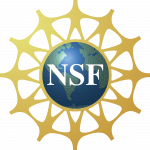Collaborative Research: Dispersal Depth and the Transport of Deep-Sea Methane-Seep Larvae Around a Biogeographic Barrier (SALT)
Sponsor: National Science Foundation

Collaborators
North Carolina State University: David B. Eggleston, Ruoying He
University of Oregon Eugene: Craig M. Young
Western Washington University: Shawn M. Arellano
Funding Period
August 2019 – July 2022
Description
This project addresses a biogeographic conundrum by investigating where and how the larvae of methane seep animals disperse. Similar deep-sea methane seeps are found in the Gulf of Mexico and on the Atlantic Continental margin of the U.S., yet many of the chemosynthetic species living in the GOM are absent from apparently suitable Atlantic seeps. It is hypothesized that species differences in dispersal depth may explain this major biogeographic pattern. Larvae will be sampled using the SyPRID plankton sampler deployed on AUV Sentry, and by trapping larvae in year-long deployments of larval collectors on the sea floor. The work will focus on seep sites at three depths on each side of the Florida peninsula. Oxygen isotopes and elemental composition of larval and juvenile mollusk shells will be used to obtain independent information about the depths where larvae drift and the variability in dispersal trajectories. Knowledge of connectivity among deep-sea metapopulations is central to predicting population and community dynamics, as well as guiding conservation and understanding biogeographic patterns. Biophysical models of dispersal and connectivity require data on biological parameters such as spawning times and locations, planktonic larval duration, vertical distribution in the water column, and swimming behavior. Vertical movements and other dispersal strategies may have profound effects on metapopulation connectivity and biogeography, yet the extent and timing of vertical migrations remain unknown for all deep-sea larvae. This project will produce the first deep-sea biophysical models that are informed by multiple biological parameters measured empirically.
Results
Work is in progress.
Visit project web site here.
